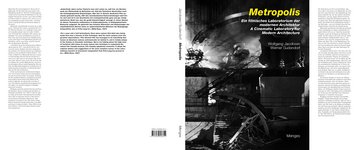Metropolis. A Cinematic Laboratory for Modern Architecture, Ein filmisches Laboratorium der modernen Architektur

| Autor | Werner Sudendorf, Wolfgang Jacobsen |
|---|---|
| Verlag | Edition Axel Menges |
| Erscheinungsjahr | 2001 |
| Seitenanzahl | 240 Seiten |
| ISBN | 9783930698851 |
| Format | |
| Kopierschutz | DRM |
| Geräte | PC/MAC/eReader/Tablet |
| Preis | 47,99 EUR |
»For a year and a half beforehand, there were rumors that what was being made here was a miracle of film technique. And the facts surpass even the greatest expectations. This German film has managed to do something that leaves all American camera achievements far behind it, and is totally unique in the history of cinematic technique. We’re not talking about the high level of technical skill alone: In many scenes this technique is completely dissolved into visually musical, into visually symphonic elements. It obeys the subtlest wishes and suggestions of the most sensitive nerves of the extraordinary maestro of movement composition that Fritz Lang has proved to be.« (Willy Haas, 1927)
What links film and architecture? Above all it is Metropolis, the film that Fritz Lang made in the Babelsberg studios in 1925/26. Its extravagance created enormous financial difficulties for Ufa, the biggest German film concern, but it had a brilliant première in Berlin in January 1927, went on to enjoy unparalleled success world-wide – and then came to symbolize (film) architectural design for the future. Metropolis, internationally renowned as a major piece of German film culture, represents film art in the Weimar Republic in an artistically unique and yet unusually popular way, but it also contains one of the first fully-formulated 20th-century city fantasies. Fritz Lang, stimulated by a journey to New York, had his architect Erich Kettelhut build a city of the future in the Babelsberg Studios outside Berlin, which, as a vision, went far beyond the real skyscraper silhouette.
Luis Buñuel wrote the following about Metropolis as early as 1927: »Henceforth and for ever more the scenic designer has been replaced by the architect. The cinema will serve as a faithful interpreter of the architect’s boldest dreams.« The Tower of Babel from Metropolis has been a piece of urban fantasy that has inspired architects of every colour right down to the present day. American urban visions in films of the 80s and 90s, like for instance the cult film Blade Runner, would be inconceivable without Lang’s Metropolis. Now as then the Metropolis designs are considered to be highly-developed examples of a Modemist laboratory for film and architecture.
All the surviving scenic architectural designs, over 200 working, factory and set photographs as well as numerous other documents, including the film architect’s hitherto unpublished memoirs and working reports have been placed at the authors’ disposal. As well as this, other photographs from the Cinémathèque Française and a bundle of over 300 hitherto unpublished photographs from the estate of a German emigrant to Australia have been included. Wolfgang Jacobsen studied German and English literature, theory of drama and art history in Göttingen and Berlin, from 1982 to 1991 he was an editor at the Berlin International Film Festival, since 1991 he has been director of the Stiftung Deutsche Kinemathek’s publications department. After working for five years in the Karl Hanser Verlag Werner Sudendorf studied philosophy, journalism and theory of drama in Berlin. Since 1980 he has been director of the Stiftung Deutsche Kinemathek’s collections department.

















